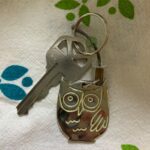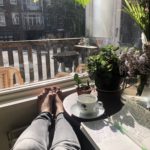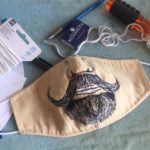Interview with artist Marta Colpani
Having weathered several technological glitches that threatened to keep us apart, Marta Colpani and I are sipping coffee together at the Stedelijk museum – a small white square table between us, still an empty canvas on which we may or may not be able to establish common ground.
I can’t help but scan the setting, reflecting on the fact that a large part of Marta Colpani’s work to date is centred around the “perceptive and affective engagement with the environment”, where the individual experience of it serves as a process to discover one’s place and identity within a space shared by many. The latter, Colpani regards as an essential step for arriving at a “new, shared meaning”, where individual experiences are interwoven into a common story.
“To truly share a space requires the willingness to have a conversation where we could approach each other. Otherwise I would just stay on my side of the experience, and you stay on yours. And in the end each of us leaves with what she came. Today, people seem to withdraw really easily when they think they cannot have it their way. And it became seemingly uncomplicated, too: if you are not happy in a place, you simply move away. With the elusive sense of freedom that we have today, many choose the option to leave rather than to negotiate their positions and maybe to settle for a compromise in the end.”

Image from workshop Exercise in power: distance (2016)
Colpani herself was done compromising when she left home. Born in Piacenza, Italy as the first and most headstrong of six siblings, she also had to share her home and parental attention with one more adopted brother and a long line of foster children, many of them with special needs, while her parents were both working full time. Her memories of her childhood home are not lacking humour, with some moments sharpened to a density resembling the atmosphere of “Clockwork Orange”. But with so many people demanding a significant share of attention, there was no room left to negotiate, and when in 2006 the possibility presented itself – she took off.

Image from workshop Exercise in power: distance (2016)
It comes as no surprise that distance marks quite a few of her works. Since her departure from home she has covered quite a distance herself, having travelled from Italy to Vienna, Japan, Senegal, and then finally following her heart to Amsterdam – a city she had never visited before. It did not, however, turn out to be a place to compensate for whatever disappointments had impelled her to leave the coziness of Piacenza. She found herself in a broken relationship (“a disastrous failure”), as well as disenchanted with a host culture too alienating in its tendency towards conforming identities and instrumental common spaces.
However, as determined as she had been to leave home, she was equally determined not to admit to failure by returning. And in fact, lack of direction and immediate purpose proved inspirational to her. She stopped looking for her way on a map, and began to look around. As if re-creating the sensory discovery of the environment we experience as children, she began to explore her environment through movement and tactile interaction. Her new direction encompassed walking, drawing, and taking in words and objects, as if collecting traces of her own identity in this city, thus shaping a relationship that would create a sense of belonging.
It was not belonging by blending in, however, she was striving for. It was not even about staying Italian or becoming Dutch, nor about committing to one cultural canon. “I don’t like it here, I finally thought, but so what?” Colpani recounts to me. “I should be able to embrace those imperfections. And I accepted that this can be my home, if I am allowed to stay foreign in it.”
This uncomfortable state of foreignness is what attracts her in her work, too. One of her recent projects, a workshop with the title “Exercise in power: distance”, brought together seven participants, herself included, for the duration of one month. She invited them to walk every Sunday to a common meeting point, each choosing a different way, and documenting their experiences.

Participants work to create a story from the documentation collected during their individual walks.
“I started it because I thought in the end it would be about how people negotiate their own identity in order to reach a common identity, in a way. So the idea was to collect impressions and objects from our walks through Amsterdam, and in the end to make an installation with seven people, who’d bring in their different experiences, different ideas, preferences, expectations… And I envisioned that the final installation would be the object, which would incorporate all of our individual stories into one. And that this was going to be the real work, the result of what we did.
“But the content that everyone brought from their individual walks was not what made this project challenging. Each of the participants’ contributions could have been an art project in its own right – and in some cases it developed into one. But ultimately, for me it wasn’t the most interesting part. The real work was to position ourselves with the experience we brought, to try to be someone in that group. And everyone had his or her issues dealing with a constellation that was temporary, didn’t exist before, and wouldn’t exist afterwards.”

That was one of the moments that prompted her shift away from objects towards performative aspects of her work, which would “open space between things that we already know”. One of her latest projects, which was also her first collaboration with her partner Olivier Oosterbaan, was the installation “Picture/Have your picture taken” where people where invited to be photographed in front of a green screen. What they were not told beforehand was that their picture would be deleted afterwards.
“It was an uncomfortable situation for me and for the people I was photographing. Some were really taken aback when they learned that it was all for nothing. They have carefully created an image of themselves by choosing a pose, an expression, and they had to deal with the uncomfortable – and slowly performed – process without receiving anything in the end. It was almost like they felt robbed of something they already possessed. And often the person would go back and retrace his behaviour, as if trying to re-capture what exactly it was that had just been taken from him.”

Picture (2017)
Colpani does not accumulate many objects herself, but grows strongly attached to those she does possess. She would rather exhaustively mend something than replace it, and her grief over an object lost can extend over years. And, despite her extensive itinerary, she gets very much attached to places, too.
As she puts it, “Amsterdam is my home because I have lived here long enough. It’s as simple as that.”
In the end, Colpani and I spend three hours at that square white table, chatting about everything from school choices for our kids through our childhood memories, artistic concepts, fetish objects, and cell phone addiction, leaving infinitely more questions uncovered and common topics untouched. But at what point, we wonder, do the stories we share with each other become shared experiences?
“You know”, she reflects, “we can name things. What we do, what we like, where we come from. This way we are constantly exchanging classified data. I think it’s important to have a conversation in between these facts. And the goal doesn’t need to be that in the end we have a shared experience. But I think it is essential to know that this conversation is possible.”
Or as a clever fox once said, “it’s the time you have spent on your rose that makes your rose so important.”
Photo cred: Marta Colpani










